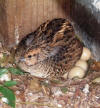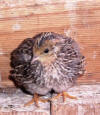. king quail
This page is Sponsored By:
Your Name, Your Address
Refer to "Advertise on web" web page |
We specialise in xxxxxxxx birds / product
Contact us on: (0X) XXXX XXXX
or e-mail us @ ............. |


- An Australian Quail (Click on photo to enlarge)
Left= young, Right=hen on 16 eggs.
- Photos donated by Jessica &
Sarah
- Scientific Name: Coturnix
chinensis
- Common Name/s: KING
QUAIL, CHINESE QUAIL, CHINESE PAINTED QUAIL.
- Sub Species in country / area of origin:
2 in Australia, plus others overseas.
- Origin / Distribution: Across
northern Australia, down east coast of Australia and across to South
Australia.
- Habitat In Wild: Thick grasslands.
- Status In Wild: Secure in northern
Australia but declining elsewhere.
- Status In (Australian) Captivity:
Very common, but pure "normal" colour birds are becoming harder to
acquire.
- Age To Sexual Maturity: ?
- Adult plumage: attained at about
2
months
- Best breeding years (estimate):
6 months to about 3 years
- Sexing: Monomorphic
/ Dimorphic.
Juvenile cock birds usually start to show the throat
colouration at about 3 weeks of age.
- Colour mutations: Yes.
- Availability: Pet shops and bird
dealers.
- Temperament: Ideal beginners
quail. One of the most commonly kept bird in aviculture. Often
kept with finches and parrots in aviaries. One of the least
expensive of all birds and is easy to breed. Hatchling baby quail
are capable of getting through 13 mm (half inch) aviary wire.
Mouse proof wire ( 7mm) may be necessary to prevent escapes.
Generally kept one pair per aviary or one cock bird with multiple
hens. Some hens will lay eggs but have no interest in incubating
the eggs. Will breed year round.
- Cost (Victoria) Per Pair: -
Normal colour (Approx.) $10
- Description Of Adults: Smallest of the Coturnix quail.
- Length: Approx. 130 mm (or approx. 5 inches)
- Colour ( "normal" colour ): Refer
photos above.
- Weight: Approx. 40 gms (or approx. 1.4 ozs)
Aviary
Notes:
Level Of Knowledge Required: Beginner / Intermediate / Advanced / Specialist
Breeders Only.
Government Regulations & By-Laws:
Refer to " Government Laws " web page.
Housing Requirements: Refer to "
Quail " web page for general
details on the housing of quail or read on for specific details for this
bird..
Compatible with most finches, small
parrots, doves and pigeons. King quail can often be successfully
bred in a colony situation. King quail can be successful in a
relatively small cage/aviary of about 1 square metre per pair.
Hatchling baby King quail are capable of getting through 13 mm (half
inch) aviary wire. Mouse proof wire ( 7mm) may be necessary to
prevent escapes.
Quail that are noisy, especially in the
morning, should be housed in an aviary most distant away from
neighbours.
Baby King quail can drown in the water
bowl. To minimize the risk of the young drowning, a shallow
container/bowl/dish can replace the usual parrot or finch water utensil.
Small pebbles or small clean rocks can be placed in the shallow water
bowl to help reduce the risk of a young quail drowning.
Diet / Feeding: Refer to "
Quail " web page for general
details on the feeding of Quail or read on for specific details for
this bird.
Probably the easiest of all the species
of quail to feed. Good quality finch or small parrot mix plus
insects, green grasses and vegetable green foods as per "Quail" web page. King
quail are less reliant on live foods than other quail for good breeding
results. May eat some of the commercial poultry pellets.
King quail have a big appetite for live
foods and will often out compete other birds for their fair share.
Finches will benefit from a separate supply well out of the reach of the
quail.
Nesting:
- Nesting months: May breed
all year round if conditions are suitable. Seasons spring to
autumn are generally the most productive.
- Nest location: On the
floor in a basic nest usually at the back of the aviary in a
secluded spot.
- Nest material: Dry
grasses and leaves.
- Who incubates the egg/s:
Hen / cock / both share.
Breeding: Egg Colour
Light brown with fine black spots. Clutch/s per year =
multiple. Eggs per nest 4 - 10, sometimes more. Incubation
approx. 18 - 20 days.
Independent by the age of about 4 - 6 weeks.
Photo, above right, shows a healthy, happy hen
sitting on 16 eggs. The hen is capable of covering and incubating
all the eggs.
The eggs are laid on a daily basis and
incubation starts when the last egg has been laid. The young usually all hatch about the
same time. They grow fast and are fully feathered just after 2
weeks of age. They are capable of flight before the age of 3
weeks.
King quail will probably incubate and
raise their own young. Hatchling baby quail are capable of
getting through 13 mm (half inch) aviary wire. Mouse proof wire (
7mm) may be necessary to prevent escapes.
Artificial incubation and hand
rearing or fostering will not be covered on this web site. It is
too complex and diverse in nature to be attempted here.
Health Issues: Refer to "Avian
Health Issues" web page for information and references.
- Worming and parasite control
and Quarantine requirements of new bird/s or sick bird/s are
considered to require veterinary advice and therefore not covered on
this web site. Refer "Avian Health Issues"
web page option.
- Avian medicine is advancing
at a rapid pace. Keep updating your knowledge and skills.
General
References: Refer to references listed on "Book References"
web page.
Specific
References:
- Australian Aviculture
- A/A Vol 53 No. 7 July 1999 Page 143-144
- A/A Vol 51 No. 5 May 1997 Page 107-109
- A/A Vol 40 No. 7 Jul 1986 Page 167-169
- A/A Vol 36 No. 12
Dec 1982 Page 276-279 (Inc photo)
- A/A Vol 36 No. 1
Jan 1982 Page 7-8
- A/A Vol 25 No. 9 Sept 1971 Page 146-148.
- A/A Vol 25 No. 5 May 1971 Page 68.
- A/A Vol 23 No 2 Feb 1969 Page
23.
- A/A Vol 20 No 5 May 1966 Page 68-70.
- A/A Vol 20 No 4 Apr 1966 Page 56-57.
- A/A Vol 20 No 3 Mar 1966 Page 49-51.
- A/A Vol 14 No 5 May 1960 Page 76.
- A/A Vol 12 No 10 Oct 1958 Page 132, 136.
- A/A Vol 12 No 3 Mar 1958 Page 48.
- A/A Vol 10 No 11 Nov 1956 Page 130.
- A/A Vol 9 No 12 Dec 1955 Page 147-148.
- A/A Vol 5 No 10 Oct 1951 Page 116-119.
- A/A Vol 5 No 1 Jan 1951 Page 7.
- A/A Vol 4 No 5 May 1950 Page 58.
- A/A Vol 3 No 9 Sept 1949 Page 99.
- A/A Vol 1 No 3 Mar 1947 Page
- The Bulletin No 24, Oct 1944 Page 2 - 3.
- Australian Birdkeeper
- ABK Vol 2 Issue 11. Oct-Nov 1989 Page 429-430
Top of - king quail - Page |

